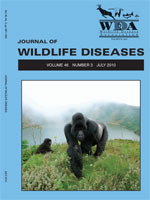A moribund 5-year-old female northern river otter (Lontra canadensis) was found on the bank of a river known to be extensively contaminated with mercury. It exhibited severe ataxia and scleral injection, made no attempt to flee, and died shortly thereafter of drowning. Tissue mercury levels were among the highest ever reported for a free-living terrestrial mammal: kidney, 353 μg/g; liver, 221 μg/g; muscle, 121 μg/g; brain (three replicates from cerebellum), 142, 151, 151 μg/g (all dry weights); and fur, 183 ug/g (fresh weight). Histopathologic findings including severe, diffuse, chronic glomerulosclerosis and moderate interstitial fibrosis were the presumptive cause of clinical signs and death. This is one of a few reports to document the death of a free-living mammal from presumed mercury poisoning.
How to translate text using browser tools
1 July 2010
Mercury Poisoning in a Free-Living Northern River Otter (Lontra canadensis)
Jonathan M. Sleeman,
Daniel A. Cristol,
Ariel E. White,
David C. Evers,
R. W. Gerhold,
Michael K. Keel
ACCESS THE FULL ARTICLE

Journal of Wildlife Diseases
Vol. 46 • No. 3
July 2010
Vol. 46 • No. 3
July 2010
Lontra canadensis
mercury poisoning
northern river otter
Virginia




